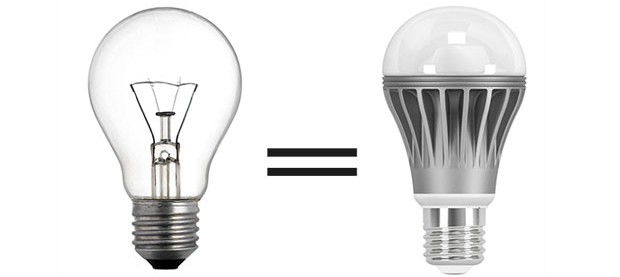What is measured in lumens - how to calculate the value
Luminance in living and working areas is measured in lumens, but not everyone knows what it is and how to do the calculations correctly. To understand the subject is not difficult, it will help you choose the right bulbs for any conditions. In addition, if you have the right data at hand, you can convert to lumens other units of measurement, if the data on the luminous flux is not on the package.
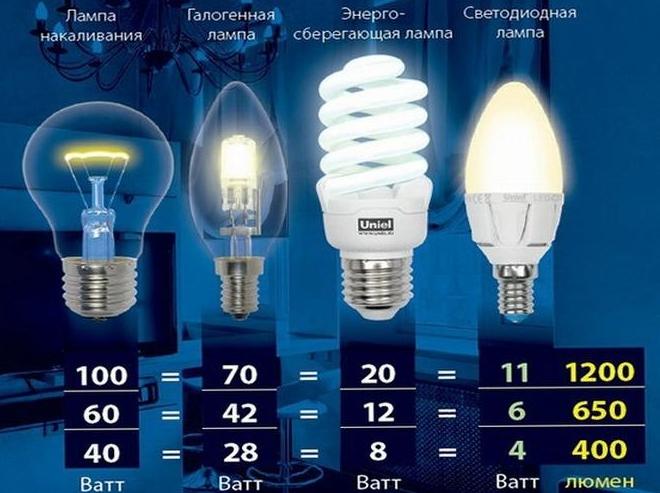
What is a lumen
As a part of the international system of units, lumen stands for the intensity of luminous fluxwhich emanates from a particular source of light. The luminous flux in lumens is referred to as Lm or Lm. It is equal to the luminous flux coming from an isotropic source with a luminous intensity of 1 candela.
This figure is universal and is used for all types of lamps and luminaires, which simplifies calculations. The option of selecting light sources in the house or apartment by wattage is long gone. It is much more convenient and accurate to use lumens, because they reflect the strength of the luminous flux, rather than the energy consumed.
By the way! The strength of the light does not depend on its temperaturemeasured in Kelvin. Lighting can be warm, neutral, or cool, but have the same lumens.
How many lumens in 1 watt bulb
It's easiest to use a lumen table for the most common types of bulbs and their wattage options. There aren't many varieties, so you can quickly orient yourself and find the optimum value. All data are averaged as values may vary depending on design and manufacturer.
| Luminous flux in lm | Incandescent bulbs (W) | LED versions (W) | Fluorescent lamps (W) |
| 200 | 20 | 2-3 | 5-7 |
| 400 | 40 | 4-5 | 10-13 |
| 700 | 60 | 8-10 | 15-16 |
| 900 | 75 | 10-12 | 18-20 |
| 1200 | 100 | 12-15 | 25-30 |
| 1800 | 150 | 18-20 | 40-50 |
| 2500 | 200 | 25-30 | 60-80 |
Over time, incandescent bulbs decrease in performance due to thinning of the filament. Fluorescent and LED variants also decrease in brightness, but not so much.
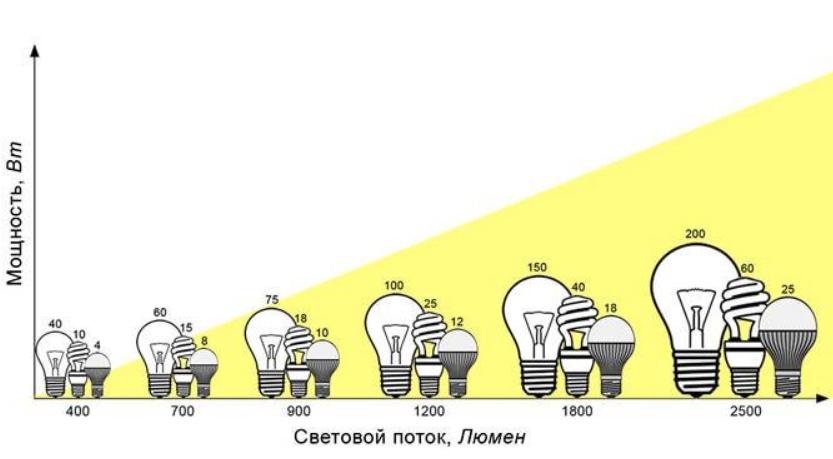
It is best to study the information on the packaging, there is usually accurate data from which you can start. The ratio may change, as there are now new types of diodes with increased brightness, which are much more efficient, but also consume less electricity.
If there is no data on how many lumens in a 100W incandescent bulb, which is often the case, you can do the calculations yourself. Even if you don't have a table handy, it's not difficult to remember the ratio. There are approximately 12 lumens of luminous flux in 1 watt of power. Using this information, it is not difficult to determine the figures for any type of option. Actual figures may differ, but not significantly. Usually, products with filament are taken with a 20-30% brightness reserve to eliminate any problems.
Determine lumens in LED bulbs much more difficult. It all depends on the voltampere characteristics of the diodes used, as well as the type of diffuser, the location of the elements and the cooling system. So it is necessary to study the information on the package or in the package insert, if available. Usually this type of lamp has all the necessary data. But it is important to remember that the actual values may differ from the stated values, especially for cheap products. Therefore, it is worth buying products from reputable companiesthat have proven themselves.
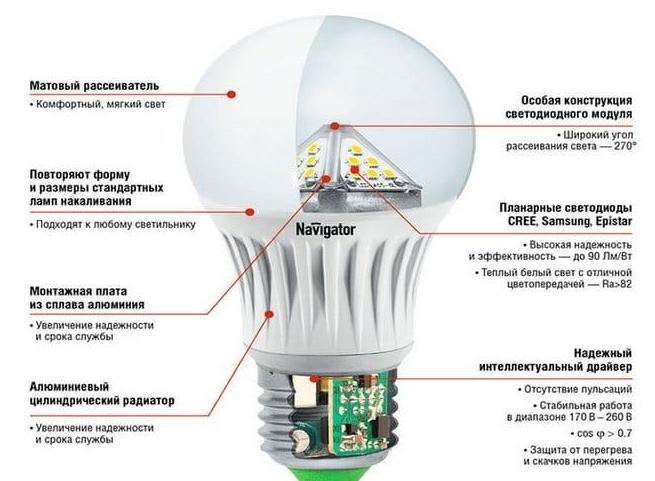
To find out the ratio of Lm in LED lamps and other types of products, the easiest way is to use the table in this section. With its help, you can quickly orient yourself in order to understand what power LED version is needed instead of incandescent or fluorescent bulbs.
Determine the indicators by eye is difficult, because the brightness can be perceived differently depending on the height of the location of the lamp. Also, the figures are affected by the color of the walls, floor and ceiling, depending on this changes light reflection. The easiest way to measure lumens in lamps is to use a luxmeter, so called a special device that shows the actual illumination in lux.
Measurements are made in several places in the room, because it matters not only the brightness, but also the uniformity of light. For living rooms you need to check the values at floor level, for offices and factories measurements are made on work surfaces. So you can quickly check whether the specified data correspond to the actual figures.
In this video we tell you what are watts, luxes and lumens in the context of LED light.
Translation of lumens to other units of measurement
Sometimes you need to convert lumens to watts or lux. You can use online calculators to do this. And if you do not have them handy, then simple guidelines are useful to help you do the calculations manually, there is nothing complicated about the process. The ratio varies with different types of equipment, so you need to select the appropriate option before you translate the data:
- The average ratio of power to luminous flux in incandescent lamps is 1:12. But there are peculiarities here: if the 100-watt product gives a flux of about 1200 lumens, and the 60-watt option - 600, then the 40-watt bulb provides only 400 Lm. That is, the low wattage versions (up to 40 watts) will have a ratio of 1:10.
- У arc mercury lamps the values are stable and almost always amount to 58 lumens per each watt of power.
- Lamps DNAT lamps have different ratios depending on the wattage. For 70W models it is 1:66, for 100, 150 and 250W products 1:74, the most powerful 400W lamps have a 1:88 ratio. Efficiency increases with increasing wattage.
- Energy saving fluorescent variants are converted at the rate of 60 Lm per each watt of power. But there is a peculiarity - over time, the characteristics of the phosphor decreases and the actual performance will be much lower than that of a new product.
- LED (LED) luminaires filament type (with a transparent bulb that does not impede the propagation of light) produce 100 Lm per watt of power.
- LED bulbs with a diffuser have a ratio of 80-90 Lm per W. But there can be deviations here, because the light transmission of the diffuser can vary.
If you want to measure with a luxmeter, you should keep the light on for an hour and a half or two hours. This is especially important for LED equipment, because its indicators may decrease as it heats up, if the cooling system is not made properly.
Sometimes it is necessary to translate luxes into lumens. It is important to understand the difference between these terms. If lux indicates the luminous flux coming from a certain direction, then lumen indicates the strength of the light source.
That is, the indicator in lumens reflects how much light is emitted by the lamp, but it can be distributed in all directions. The SNiP states that one lux is equal to one lumen, distributed over an area of one square meter.
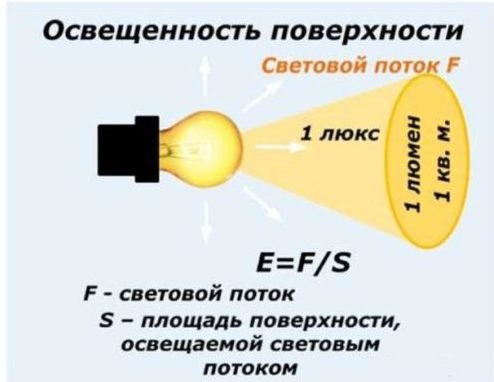
There are no separate values for different types of lamps, a simple formula is needed to convert one quantity to another. Lux equals the amount of lumens divided by the area per square meter.
How to choose the right lamp for the right number of lumens
Calculating lumens is not difficult if you use the recommendations of the Building Regulations and keep in mind some tips:
- There are sanitary norms of illumination for each room. For bathrooms, toilets, utility rooms, corridors and hallways, the indicator is 50 lux. For living rooms and kitchens it is 150 lux. Children's rooms and play areas need at least 200 lux. Workrooms, home offices and libraries are illuminated according to the norm of 300 lux.
- You should multiply chosen norm by the area of the room. The result will show the total illumination needed for a particular room. At this figure and should be guided.
- Consider the number of bulbs and their location. For small rooms, a chandelier in the middle that evenly distributes light will be enough. And if the room is large or elongated, it is better to use more lamps with less brightness and arrange them evenly or put 2-3 chandeliers.
Calculate the optimum luminous flux in lumens is not difficult if you know the ratio of this indicator to the power of the main types of lamps. When choosing equipment, it is necessary to remember that you can not greatly exceed the recommended norms.
